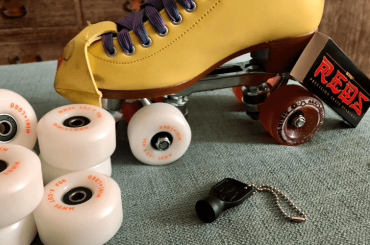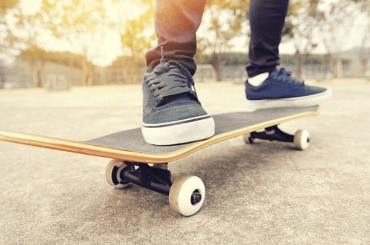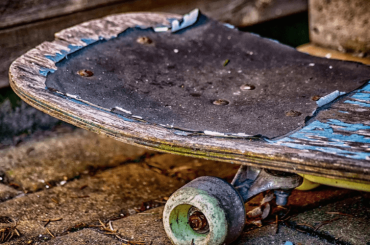Skateboarding is a popular sport, but it can also be dangerous. Skaters can suffer a wide range of injuries, from scrapes and bruises to serious head injuries. In this blog post, we’ll take a look at some of the most common skateboarding injuries and how to avoid them. Stay safe out there!
Most common skateboarding injuries?
Skateboarding injuries can range from scrapes and bruises to more serious injuries like concussions and broken bones. The most common skateboarding injuries include
- Ankle Sprains
- Knee Injuries
- Sprains and strains
- Bruises
- Cuts and scrapes
- Concussions
- Broken bones
- Skateboarding is a relatively safe sport
Ankle Sprains due to Skateboarding?
Ankle sprains are the most common type of skateboarding injury. The ankle is a complex joint that is made up of bones, ligaments and tendons that work together to allow us to move our feet.
Ligaments are tough bands of tissue that connect bones and help to stabilize joints. When ligaments are stretched or torn, this is called a sprain.
Ankle sprains usually occur when the foot lands awkwardly on an obstacle or the ground, causing the ligaments to stretch beyond their normal range of motion. This can result in pain, swelling and bruising.
Skateboarders are at a higher risk for ankle sprains because of the repetitive twisting and turning motions that are required to perform many tricks.
Wearing a properly fitting ankle brace can help to prevent ankle sprains. Ankle braces support the ligaments and tendons around the ankle joint and help limit the range of motion, preventing the ligaments from being stretched too far.
If you do suffer from an ankle sprain, it is important to seek medical attention and follow the proper rehabilitation protocol to prevent further injury.
Knee Injuries due to skateboarding?
The knee is another common site of injury for skateboarders. The knee is a complex joint that is made up of the femur (thigh bone), tibia (shin bone), patella (knee cap) and several ligaments. The ligaments around the knee joint provide stability and allow the knee to move through its normal range of motion.
Wrist and Hand Injuries due to skateboarding?
Wrist and hand injuries are also common among skateboarders. The wrist is a complex joint that is made up of the radius, ulna and several ligaments. The bones and ligaments in the wrist work together to allow us to move our hands.
Skateboarders often put their hands down to catch themselves when they fall. This can lead to scrapes, bruises and fractures. Wearing gloves can help to protect your hands from being injured in a fall.
Head and Neck Injuries due to skateboarding?
Head and neck injuries are the most serious type of skateboarding injuries. The head and neck are protected by the skull and vertebrae, which are strong bones that help to protect the brain and spinal cord.
The most common type of head injury in skateboarding is a concussion. A concussion is a type of brain injury that occurs when the head is suddenly and violently jarred.
Did You Know: Skateboarding Rules & Skateboarding Laws
Back and Spine Injuries due to skateboarding?
Back and spine injuries are also common among skateboarders. The spine is made up of a series of bones (vertebrae) that protect the spinal cord. The vertebrae are connected by ligaments and muscles, which allow the spine to move.
Skateboarders often fall back when they lose their balance or land a jump incorrectly. This can lead to back injuries, such as fractures, dislocations and sprains. Wearing a back brace can help prevent back injuries by providing support to the spine and limiting its range of motion.
Bone Fractures due to skateboarding?
Bone fractures are a common type of skateboarding injury. The bones in the body are protected by a layer of tough tissue called cortical bone. This type of bone is strong and resistant to fracture.
Skateboarders often land on their hands and wrists when they fall, which can lead to breaks in the bones of the wrist and hand.
How to Stay Safe from Skateboard Injuries?
There are several things you can do to help prevent skateboarding injuries:
- Wear protective gear, including a helmet, elbow and knee pads and wrist guards.
- Avoid skating in areas with obstacles or traffic.
- Practice skating in a safe area until you are confident in your ability to control your board.
- Start by learning basic tricks and progress to more difficult tricks gradually.
- Ask a friend or skateboarding instructor for help if you are having trouble learning a trick.
- Take breaks often and rest when you are tired.
Skateboarding is a fun and challenging activity that can be enjoyed by people of all ages. However, it is important to be aware of the risks associated with the sport and take measures to prevent injuries.
Wearing protective gear, practicing in a safe area and learning tricks gradually are all good ways to stay safe while skateboarding.
FAQS – Common Skateboarding Injuries
What are the chances of dying skateboarding?
The chances of dying skateboarding are relatively low. However, the risk of injury is always present when participating in this activity. Wearing proper safety gear can help to reduce the risk of serious injury or death while skateboarding.
At what age should you stop skateboarding?
There is no definitive answer to this question. Some people continue to skateboard well into their 40s and 50s, while others may choose to retire from the activity at a younger age. Ultimately, it is up to the individual to decide when they want to stop skateboarding.
Is skateboarding safer than biking?
There is no definitive answer to this question as both activities come with their own set of risks. However, skateboarding may be considered slightly less risky than biking, as there are no handlebars or pedals that can get caught on objects and cause a fall.
Additionally, skateboarding generally takes place on smooth surfaces, while biking often occurs on rougher terrain.
What is a hot pocket injury?
A hot pocket injury is a type of burn that can occur when coming into contact with the pavement at high speeds. This type of injury is most commonly seen in skateboarders and can be extremely painful. Hot pocket injuries can often lead to permanent scarring.
Is skateboarding well for your core?
Skateboarding is a great way to work your core muscles. It requires balance and stability, which can help to tone and strengthen your abdominal muscles. Additionally, skateboarding can be a great cardio workout, which can also help to improve your overall health.
What is a Swellbow?
Swellbow is a web-based tool that helps businesses track their social media activity and measure their social media performance. It provides users with insights into their social media reach, engagement and followership.
Additionally, Swellbow offers users the ability to create custom reports and export data for further analysis.
Final Thoughts:
Skateboarding is a great way to get around and have fun, but it’s important to be aware of the risks involved. Knowing how to stay safe while skateboarding can help you avoid common injuries.
Wearing the proper safety gear, being aware of your surroundings and knowing how to fall correctly are all important ways to stay safe while skateboarding. If you follow these tips, you’ll be able to enjoy this activity for years to come without having to worry about getting injured.





